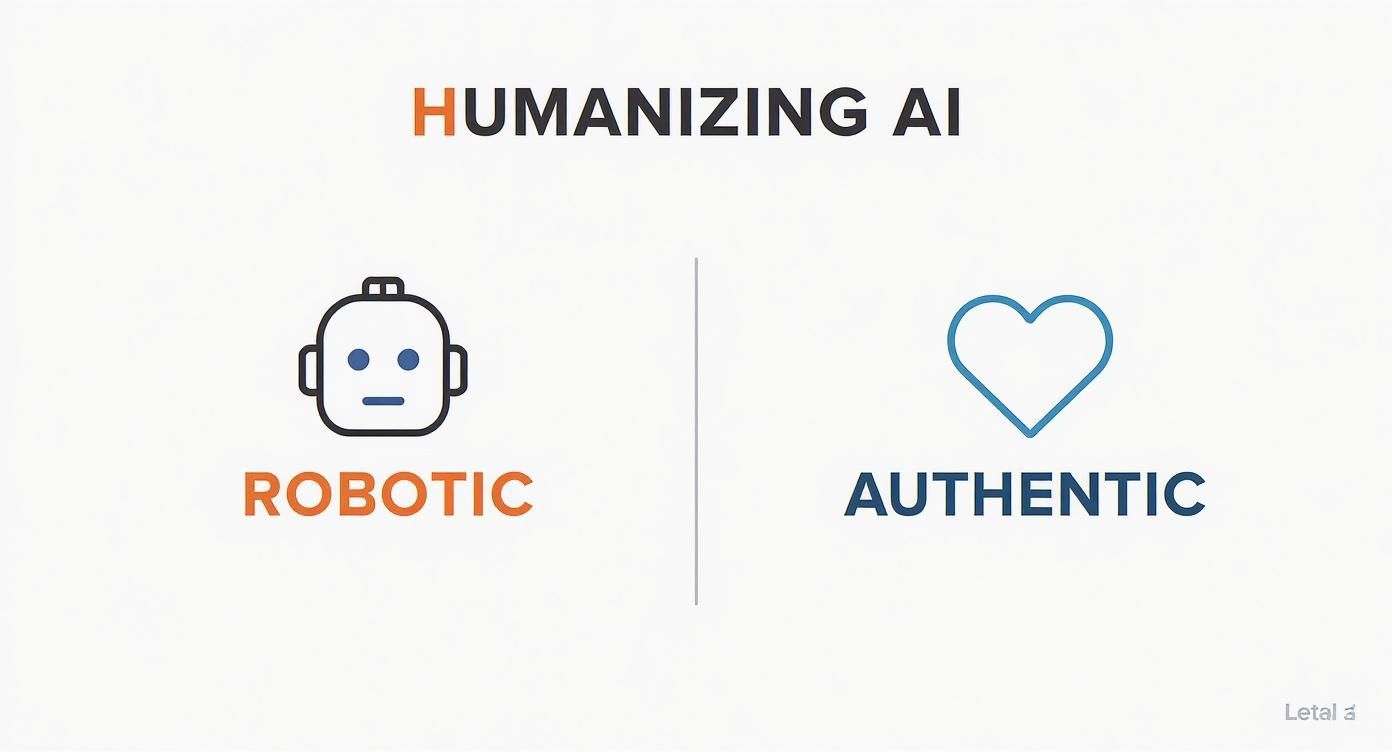How to Humanize AI Text: A Practical Guide for Creators

Think of humanizing AI text as less of a technical task and more of an art. It’s about taking the sterile, fact-based draft an AI gives you and breathing life into it. You do this by weaving in your unique voice, sharing personal stories, and playing with sentence structure to create an emotional connection. This transforms a monologue into a genuine conversation, building a real relationship with your readers. It’s about making your content feel human, not just tricking a detector.
Why Robotic AI Content Fails to Connect
AI is an incredible assistant, there's no doubt about it. But its default writing style often lacks the very thing that makes content stick: personality. Your readers are savvy; they can spot generic, robotic text from a mile away, and when they do, your credibility takes a hit. Your message just doesn't land.
This happens because AI models are trained on massive datasets to find patterns and predict the next logical word. They aren't built to feel empathy, share a funny anecdote from last Tuesday, or understand the nuances of your industry. The result? Content that is often grammatically flawless but completely hollow. It delivers information, but it won’t inspire anyone, build trust, or create a memorable experience.
The Growing Need for an Authentic Touch
As more content creators and marketers embrace AI, the internet is becoming a sea of sameness. A recent HubSpot report is a real eye-opener: marketer usage of AI shot up from 21% to 74% in a single year. Standing out in that crowded space means bringing your unique human perspective to the forefront.
It's not just a hunch; the data backs it up. A significant 86% of marketers who use AI are already spending time editing and humanizing what it produces. They know the raw output just isn't enough to connect with their audience.
This quick visual breaks down the key differences between a robotic draft and authentic, humanized writing.

As you can see, AI can give you a solid foundation, but it's your human element that adds the heart and soul—the stuff that actually connects with people.
To get a clearer picture, let's look at the specific traits that separate a raw AI draft from a piece of content that feels genuinely human.
AI Text vs Humanized Text: Key Differences
This table breaks down the core distinctions between what an AI produces on its own and what you get after a thoughtful human touch.
| Characteristic | Raw AI-Generated Text | Humanized AI Text |
|---|---|---|
| Tone of Voice | Often generic, formal, or overly academic. | Unique, conversational, and reflects your brand's personality. |
| Sentence Structure | Tends to be repetitive and predictable. | Varied, with a mix of short, punchy sentences and longer, complex ones. |
| Storytelling | Lacks personal anecdotes, experiences, or emotion. | Includes personal stories, case studies, and emotional context. |
| Word Choice | Uses safe, common vocabulary and AI-favored words like "leverage." | Employs specific, evocative language and industry-specific jargon naturally. |
| Flow and Rhythm | Can feel disjointed or formulaic between paragraphs. | Reads smoothly with natural transitions and a conversational rhythm. |
The differences are stark. One version informs, while the other engages, persuades, and connects on a much deeper level.
More Than Just Bypassing Detectors
Ultimately, learning to humanize AI text isn't a cat-and-mouse game with detection tools. That’s a small part of a much bigger picture. The real goal is to craft content that resonates with actual people.
The real goal of humanizing AI content is to create a genuine conversation. When you write for people first, authenticity is the natural result, building the trust and engagement that algorithms can't replicate.
Here at PureWrite, we believe AI is a tool to amplify your creativity, not replace it. Our mission is to help you take those AI-generated drafts and sharpen them into compelling pieces that truly sound like you. Ready to make your content more authentic? Try PureWrite for free to see how easy it is.
Finding and Infusing Your Unique Voice

Here's the most direct way to make AI text sound human: inject your authentic voice into it. An AI has no personal experiences, no hard-won industry perspective, and definitely no unique sense of humor. Your voice is what turns a generic draft into something that actually sounds like you or your brand.
Think of the AI as providing a basic blueprint for your content. You're the architect who comes in to add the character, style, and finishing touches that make it special. This means swapping out its bland, generic vocabulary for the words you'd actually use in a real conversation.
Making It Sound Like You
Here’s a simple but incredibly effective test: read the AI-generated text out loud. Seriously. If it sounds clunky, overly formal, or just not like something you would ever say, it's time for a rewrite. Your ear will catch the awkward phrasing and robotic sentences your eyes might skim over.
To get started, focus on these key areas:
- Word Choice: Hunt down those stuffy AI words. Ditch "utilize" for "use," and swap "thus" for a simple "so."
- Anecdotes: Weave in a quick, relevant story. For a marketer, this could be a client success story. For a student, it might be a personal insight from a lecture. This adds a layer of credibility that no AI can fake.
- Industry Lingo: Don't shy away from the jargon or slang your audience actually uses. It's a subtle signal that you're an insider who genuinely gets their world.
The goal is to stop just informing and start connecting. Your voice is the bridge that turns a passive reader into an engaged follower who trusts what you have to say.
Let's look at a real-world example. An AI might produce something like: "It is imperative for businesses to leverage social media platforms to enhance customer engagement."
A much more human version? "If you're not using social media to connect with your customers, you're leaving money on the table. It’s that simple." See the difference? The second one is direct, confident, and has a real point of view.
Making these small but meaningful tweaks teaches your audience what to expect from your content. We have a guide full of tips to help you rewrite AI text to sound human. At PureWrite, our tools are built to spot these robotic patterns, making it much easier to infuse your voice and personality into every piece you create.
Weave Stories into Your AI Drafts
Facts are great for informing, but stories are what truly connect. While an AI can spit out organized data and bullet points with impressive speed, it can't build a compelling story that grabs a reader’s attention and holds it.
This is where your human touch is essential. Your job is to find the narrative hidden within that dry AI draft.
Look for places to inject mini-stories, real-world examples, or relatable analogies that make your points pop. Think about it: a quick story about a client’s big win or a personal mistake you learned from is infinitely more memorable than another generic bullet point.
Build a Narrative Arc
Even a simple how-to guide can benefit from a basic story structure. You need a beginning that sets the stage (the problem), a middle that explores the journey (the solutions and hurdles), and an end that delivers a satisfying conclusion (the key takeaway).
This structure gives your reader a clear path to follow, making the information much easier to process and remember.
An AI might give you something functional but flat:
- AI Output: "Proper email etiquette is important for professional communication. It involves timely responses and clear subject lines."
But you can breathe life into it with a personal touch:
- Humanized Version: "I once lost a major client because of a vague subject line that got buried in their inbox. That costly mistake taught me that how you communicate is just as important as what you say."
An AI can give you the "what," but your stories provide the "why." Personal anecdotes and customer success stories don't just add color—they build credibility and create an emotional connection that makes your content stick.
From Facts to Feeling
This is all about shifting from purely expository writing, which just explains things, to a more narrative style that pulls the reader in. If you want to dive deeper into this concept, we have a whole guide exploring the differences between expository vs. narrative writing.
Ultimately, stories are your secret weapon for humanizing AI text. They build trust, create a genuine connection, and make your message resonate long after someone has clicked away.
Creating a Natural Rhythm and Flow

You can almost feel when you're reading AI content. It often has a tell-tale monotonous rhythm, where every sentence is a similar length and structure. It's predictable, and frankly, it's boring. It feels less like a conversation and more like a computer reading a report out loud.
Learning how to humanize AI text is about completely shattering that robotic cadence. Your goal is to create a dynamic reading experience that pulls your audience in and keeps them engaged.
Mix Up Your Sentence Structure
The quickest way to inject a human touch is to play with sentence length. An AI draft will often give you a string of medium-length, matter-of-fact statements. Your job is to go in and shake things up.
Try combining a few related ideas into a longer, more detailed sentence. Then, follow it up with a short, punchy one to make a point. This contrast is what creates a natural-sounding flow that keeps people reading. For example, using compound sentences is a great way to link ideas without sounding choppy. We cover this in detail with plenty of examples of compound sentence.
- Short Sentences: Pack a punch. They're perfect for making a bold claim or driving a point home.
- Medium Sentences: These are your workhorses, ideal for explaining concepts clearly and concisely.
- Long Sentences: Use these to weave together complex ideas, adding depth and context for the reader.
Add Some Conversational Flair
Think about how you talk. You probably don't say, "You are going to find this interesting." You'd say, "You're going to find this interesting." Simple contractions like "you're," "it's," and "don't" instantly make your writing feel more approachable.
Another trick is to ask questions. Even rhetorical ones can pull the reader into the conversation and make them feel like a part of the discussion.
Injecting conversational elements is a deceptively simple trick. Using things like contractions and questions immediately breaks down the wall between you and the reader, making the content feel more personal and far less robotic.
Also, be on the lookout for the passive voice. An AI might write, "The blog post was generated by the tool." Flip it to the active voice: "The tool generated the blog post." It’s more direct, confident, and simply better writing.
Here at PureWrite, our entire platform is built to help you catch these things. Our tools analyze your text for rhythm and flow, flagging opportunities to turn a clunky AI draft into something that sounds like it was written by a real person.
Navigating AI Detectors with Authentic Writing

With tools like GPTZero and Turnitin becoming standard, it's natural to worry about your work being flagged as AI-generated. Whether you're a student worried about academic integrity or a marketer protecting your brand's voice, you need your work to be recognized as your own. But here’s the secret: getting past these detectors isn't about finding a clever loophole.
The best strategy is also the simplest one: focus on creating genuinely good, human-sounding writing. AI detectors are designed to sniff out patterns—the robotic sentence structures, predictable vocabulary, and stiff, formal tone that raw AI output is known for.
Write for People, Not for Bots
When you start applying the humanizing techniques we've talked about—injecting your personal voice, sharing anecdotes, and finding a natural flow—you're already sidestepping the very things these algorithms look for. Your writing stops being so predictable and starts feeling more alive. That's the hallmark of human creativity.
The goal shouldn't be to sneak past a detector. It should be to create something so valuable and authentic for your reader that its origin is never even a question. When you focus on your audience, the detection issue tends to solve itself.
Of course, if you're dealing with strict academic or professional guidelines, it helps to know how these systems operate. We have a full guide on whether https://purewrite.io/blog/can-turnitin-detect-ai if you want to dive deeper into the mechanics.
The Cat-and-Mouse Game of Detectors and Humanizers
This back-and-forth between AI detectors and humanizers is always evolving. Most AI detection tools report an accuracy rate somewhere between 65% and 90%, but they aren't foolproof. This is where top-tier humanization platforms come in. They're designed to smooth out AI-generated text so well that it sails through these checks.
For instance, a powerful humanizer can take a piece of text that gets heavily flagged and bring its AI score down to as low as 2%, making it indistinguishable from something written by a person.
At the end of the day, the best defense is a strong offense. Prioritize telling a good story and developing your unique voice. You'll end up with content that’s not just more effective, but also unmistakably human.
Common Questions About Humanizing AI Content
As we all learn to work with AI, it's natural to have a few questions. This is new territory for most of us, so let's clear up some of the common uncertainties about making AI-generated text sound like it was written by you.
How Much Editing Are We Talking About?
Honestly, it's probably more than you'd expect. Don't think of raw AI output as a finished piece. It's just a first draft—a pretty solid one, maybe, but still just a starting point. Your job is to inject your voice, weave in personal anecdotes, and meticulously check every fact.
We like to think of it with the 80/20 principle. The AI can do about 80% of the grunt work, like initial research and structuring. But you, the human expert, need to bring that critical 20% that delivers personality, builds trust, and makes a genuine connection with the reader.
Is It Ethical to "Bypass" AI Detectors?
This is a great and important question. The focus should never be on trying to "fool" a piece of software. Instead, the ethical goal is to use AI as a tool to produce genuinely high-quality content that sounds human—because you, the writer, have made it so. You'll naturally sidestep the robotic patterns that detectors look for when you focus on authentic writing.
The ethical problem comes in when someone uses AI to pass off work as their own without doing the work, especially in an academic setting.
Here at PureWrite, we see AI as an assistant. It helps you brainstorm and sharpen your ideas, but it doesn't replace your expertise. It’s about making your skills even better, not faking them.
It's telling that modern humanizing tools can hit a 98% success rate against top detectors like Turnitin and GPTZero without losing the original meaning. And with so many university students (42%) and professional writers (28%) already using them, it’s clear this is becoming a standard part of the writing process. You can discover more insights about AI humanization statistics if you're curious.
Using a tool to polish an AI draft so it reflects your voice is just smart editing. It’s no different from taking any rough draft and refining it until it’s ready for your audience—a timeless part of the writing craft.
Ready to turn those robotic AI drafts into authentic content that truly connects with your audience? Give PureWrite a try and see what a difference a human touch can make. Get started with PureWrite.